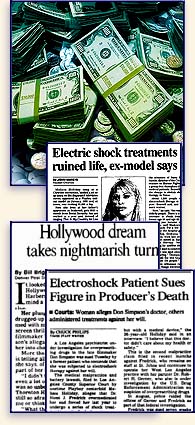


elissa Holliday seemed made for the bright lights of the entertainment world. Starting at age 10, she was singing for athletic events and convention crowds. Through the years, she won 55 beauty pageant crowns, including the title of Miss Pre-Teen America.
She sang “This Is My Country” for Lee Iaccoca and others at automobile shows, preparing herself for the career to which she aspired as a country music singer and actress. As her father, Randy Harberson, said, “I wasn’t always thrilled with the beauty pageant stuff. But when she sings, she blossoms.”
In early 1995, she landed a role on “Baywatch.” While being wooed by scouts from major film studios, she cut demo tapes for Nashville music labels.
Yet at the very time her career as an actress and singer seemed to be taking off, Melissa Holliday was quietly living day by day with intense, virtually unbearable pain.
Her problem was diagnosed as endometriosis, a condition in which uterine tissue grows in places other than the uterus, causing excruciating pain. Doctors she initially consulted put her on a drug called Zoladex.
According to a lawsuit Holliday filed in Los Angeles Superior Court with the assistance of Alexander Lampone, a medical doctor and lawyer, doctors prescribed the drug to suppress her ovarian functions and block production of sex hormones. The drug decreases estrogen levels, creating a condition the suit described as “chemical castration.” But her pain was unrelieved and Holliday continued to spiral downward.
Seeking relief from the combination of pain from the medical condition and unwanted side effects produced by the drug, she turned to gynecologist Rodney Francis. Francis referred her to psychiatrist Nomi Fredrick. According to the lawsuit, Francis has been a patient of Fredrick’s — and may even have been at the time of referral.
According to papers in the lawsuit, although Holliday made repeated inquiries to both Francis and Fredrick regarding whether to continue the Zoladex, which didn’t appear to be helping, the two doctors ignored her questions, and she stayed on the drug as her condition worsened. Ultimately, Holliday was persuaded by Fredrick to check into St. John’s Hospital and Health Center in Santa Monica on June 1, 1995.
Over-Prescription of
Multiple Potent Drugs
Once there, instead of helping Holliday resolve her physical problem, doctors virtually drowned her in a stream of drugs. As described in documents on file with the Los Angeles Superior Court, during a two-week period at the hospital under Fredrick’s care, she received the following:
- Dexedrine (an amphetamine) — up to 90 mg per day
- Depakote (an anti-convulsant) — up to 750 mg per day
- Eldepryl (a drug that inhibits certain chemicals in the brain) — 15 mg per day
- Ativan (a tranquilizer) — up to 2 mg per day
- Restoril (a sedative) — 30 mg per day
- Dalmane (another sedative) — 30 mg per day
- Wellbutrin (an anti-depressant) — 150 mg per day
- Synthroid (a thyroid hormone) — .025 mg per day
In addition, Vicodin, a powerful narcotic, and Lasix, a diuretic, were given “as needed.” “I felt like I was on a treadmill,” Holliday said. “The medication just kept coming and coming.”
“Such a rapidly changing regimen of multiple, concomitantly administered psychoactive drugs made it clinically impossible for a reasonable physician of ordinary care and prudence to realistically and correctly evaluate the mental status or clinical progress of such a patient under the influence of such a massive barrage of mind and mood altering drugs,” Lampone charged in the lawsuit.
“Such aggressive over-medication and over-prescription of multiple potent psychoactive drugs without allowing the patient time to stabilize and be properly evaluated for her response to such treatment was a breach of Dr. Fredrick’s and St. John’s duty of care to Ms. Holliday,” he stated.
As Holliday put it, “They’d given me so many drugs, I didn’t know if I was coming or going.” Although Fredrick’s attorney, David O’Keefe, asserted that the “therapy” provided was “appropriate,” it is well known that the psychiatrist he represents has been accused of overmedicating other patients, including the co-producer of some of Hollywood’s biggest hits, Don Simpson.
Simpson was found dead in his Bel Air estate in January 1996 — seven months after Melissa Holliday entered St. John’s Hospital — from a massive overdose of a combination of prescription drugs. Police found thousands of pills and tablets in Simpson’s residence following the death, many of them prescribed by Fredrick. Later that year, Fredrick’s office was raided by agents of the U.S. Drug Enforcement Administration (DEA) on suspicion that she had overprescribed drugs to Simpson and Steven Ammerman, a physician and friend of Simpson’s who had died of a similar drug overdose at the estate in September 1995.
Her Worst Nightmare
Once Melissa Holliday had, in effect, been driven out of her mind through chemical bombardment, Fredrick attempted to talk her into receiving psychiatric electric shock. “After I got there, the doctor mentioned shock,” Holliday said. “She didn’t ask me if I wanted it. She said if I didn’t want it, I’d go to the fourth floor, a lock-up ward.”
Alexander Lampone noted that it would be difficult to have devised “a more drastic alternative short of lobotomy.”
When Holliday informed the doctors that she didn’t want electric shock, she was told that if she didn’t consent, she would simply be locked up and not permitted to leave.
According to Holliday, her mother had received shock years before. “When my mother came out of electroshock therapy,” she said, “she was never the same again” — a common experience for those who have endured the brain-damaging “treatment.” (See “Annihilation Therapy.”)
Those to whom Melissa Holliday had turned for help created her worst nightmare on June 26, 1995. Robbed of her dignity and self-determination, the young actress was strapped to a table, anesthetized and paralyzed. Electrodes were fastened to her scalp and high-voltage shocks repeatedly ripped through delicate brain tissue, causing convulsions and brain damage, as well as pain, shock and trauma, according to her lawsuit.
Over ensuing days, nine shock treatments were administered to Melissa Holliday by psychiatrist Timothy Hayes, according to the suit, and she fought against each one. The legal papers tell of attempts to escape through the hospital’s elevator system, and of fighting against attendants who came to bring her for “treatments” — even biting one in her frantic efforts to stop the torture.
Finally, at the end of 44 days, Francis, Fredrick, Hayes and St. John’s had drained approximately $45,000 from Melissa Holliday’s medical insurance policy. As she had run out of coverage, an exhausted and ruined Melissa Holliday was released from the hospital.
“I Couldn’t Leave My House for Six Months”
“I’ve been through a rape,” she said, “and electroshock therapy is worse. When it was over, I couldn’t leave my house for six months. I couldn’t drive my car for eight months.” As she described it, she lost her self-confidence, energy and memory to electric shock. With the memory loss came inability to recall lines for acting roles, to play music or to sing. Instead of making $5,000 a day acting or modeling, she was unable to work.
She attempted suicide and a friend kept watch over her 24 hours a day to keep her alive. Eventually she moved to Houston to live with relatives, and applied for disability payments from Social Security, which provided $525 a month.
Some time later, she began to research the possibility of taking action against those who had drugged and shocked her in hopes of preventing others from similarly becoming victims. She found a newspaper article describing harm caused by electric shock which quoted Jerry Boswell, executive director of the Texas chapter of the Citizens Commission on Human Rights (CCHR), an organization established by the Church of Scientology in 1969 to investigate and expose criminal and abusive practices by psychiatrists. With her father, she contacted Boswell’s office in Austin.
After being informed of Holliday’s situation, Boswell accompanied her to Los Angeles, where they discussed her case with DEA officials investigating the practice of Nomi Fredrick following the overdose deaths of Don Simpson and Steven Ammerman. Holliday was also interviewed by the Los Angeles District Attorney’s Office, the Los Angeles Police Department and Assistant U.S. Attorney Mark Hardiman, who heads the prescription drug probe of Fredrick.
DEA Special Agent Abel Reynoso said, “The investigation is still on course. My people are still looking at it.” According to a source, Holliday’s case is part of the federal probe.
In October 1996, Holliday’s lawsuit was filed against psychiatrists Nomi Fredrick and Timothy Hayes, gynecologist Rodney Francis and St. John’s Hospital for professional negligence and battery. The case has not yet gone to trial.
Assault with a Deadly Weapon
“It is a clear case of assault and battery, according to the legal definition of those offenses,” said CCHR’s Boswell. “The only difference from the typical assault is that drugs and strong electrical current were used in this case instead of a baseball bat or a lead pipe.”
Eventually, Melissa Holliday received the medical care she needed and obtained some relief from the chronic abdominal and pelvic pains — help which should have come much sooner.
“What they did to me was wrong,” Holliday said. Her father uses a stronger word: “barbaric.” However described, harm in the name of help is betrayal and the crime is compounded when the bottom line appears to be money.
 Anyone who has been
similarly victimized, or who knows of someone who has, can contact the Citizens Commission on Human Rights for information and help. Telephone: (323) 467-4242 or (800) 869-2247. Anyone who has been
similarly victimized, or who knows of someone who has, can contact the Citizens Commission on Human Rights for information and help. Telephone: (323) 467-4242 or (800) 869-2247.
info@scientology.net
CCHR can also be reached on the Internet at www.cchr.org
|








 Anyone
Anyone